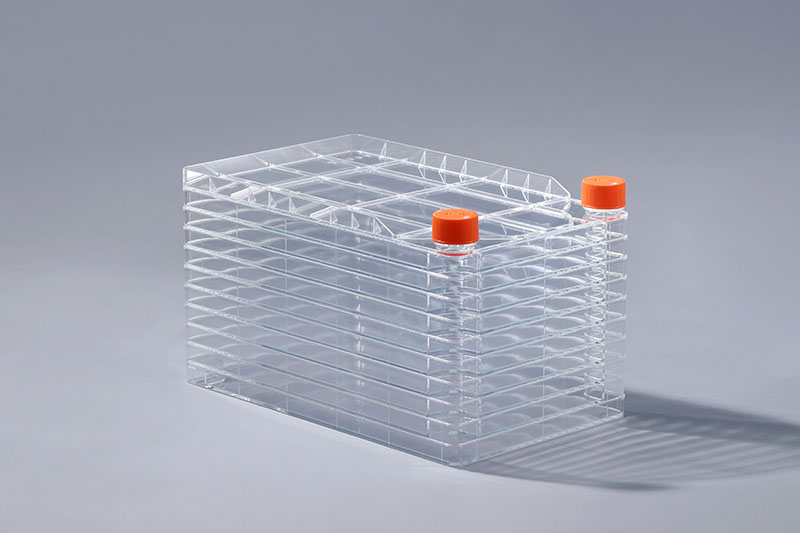সেল কালচার প্রযুক্তির উন্নয়ন এখন পর্যন্ত খুবই পরিপক্ক হয়েছে, এবং এটি মনোক্লোনাল অ্যান্টিবডি তৈরি, ভ্যাকসিন উৎপাদন, বৈজ্ঞানিক গবেষণা এবং অন্যান্য ক্ষেত্রে ব্যাপকভাবে ব্যবহৃত হয়েছে। কোষ সংস্কৃতির জন্য কোষের ভোগ্য সামগ্রীর সাহায্য প্রয়োজন। বাজারে বিভিন্ন ধরনের ভোগ্যপণ্য রয়েছে। তাদের মধ্যে, cell factory হল বিশেষ কাঠামো সহ এক ধরনের ভোগ্য।
অন্যান্য বোতল-ধরনের ভোগ্য দ্রব্য থেকে আলাদা, সেল ফ্যাক্টরি হল একটি মাল্টি-লেয়ার স্ট্রাকচার সহ একটি বিশেষ ব্যবহারযোগ্য। সাধারণ স্পেসিফিকেশনের মধ্যে রয়েছে 1 স্তর, 2 স্তর, 5 স্তর, 10 স্তর, 40 স্তর, ইত্যাদি। কোষগুলিকে সংস্কৃতি করার সময়, মাধ্যমটি ভিতরের স্তরগুলিতে ঢেলে দেওয়া হয় এবং কোষগুলি বৃদ্ধি এবং সংখ্যাবৃদ্ধির জন্য নীচের সাথে সংযুক্ত থাকে। 10-স্তর এবং 40-স্তর স্তরের উচ্চ সংখ্যার কারণে, মাধ্যম যোগ করার পরে এটি পরিচালনা করা কঠিন। সাধারণত, এটি একটি স্বয়ংক্রিয় শেকারের সাথে একসাথে ব্যবহার করা হয়। এটি বৃহৎ আকারের কোষ সংস্কৃতির প্রোগ্রামিং, অটোমেশন এবং দক্ষতা উপলব্ধি করতে পারে, যার ফলে শ্রমের তীব্রতা এবং ঘনত্ব ব্যাপকভাবে হ্রাস পায়।
এই বহু-স্তর কাঠামোর ব্যবহারে একটি বৃহৎ সংস্কৃতির ক্ষেত্র রয়েছে, যা স্থান বাঁচাতে পারে, ম্যানুয়াল ক্রিয়াকলাপ কমাতে পারে, এবং দূষণের ঝুঁকি কমায়। সংস্কৃতি এলাকার পরিপ্রেক্ষিতে, একটি 10-স্তর সেল কারখানার সংস্কৃতির ক্ষেত্রফল 36 টি-175 সেল কালচার ফ্লাস্কের সমতুল্য। স্তরগুলি একটি বিশেষ ঢালাই প্রক্রিয়া দ্বারা সংযুক্ত থাকে, যা অভ্যন্তরীণ পরিবেশের স্থিতিশীলতা নিশ্চিত করতে পারে এবং কোষের বৃদ্ধির জন্য একটি ভাল বৃদ্ধির পরিবেশ তৈরি করতে পারে৷ বায়োফার্মাসিউটিক্যালস এবং বৈজ্ঞানিক গবেষণার ক্ষেত্র। বায়োফার্মাসিউটিক্যাল শিল্পের দ্রুত বিকাশের সাথে, এই ভোগ্য পণ্যটির ভবিষ্যত বৃদ্ধির স্থানটি অপেক্ষা করার মতো।
At present, cell factories have gradually replaced some traditional cell culture consumables and become mainstream consumables in the fields of biopharmaceuticals and scientific research. With the rapid development of the biopharmaceutical industry, the future growth space of this consumable is worth looking forward to.
The FAI climbed 5.9 percent year-on-year in the first 11 months of 2018, quickening from the 5.7-percent growth in Jan-Oct, the National Bureau of Statistics (NBS) said Friday in an online statement.
The key indicator of investment, dubbed a major growth driver, hit the bottom in August and has since started to rebound steadily.
In the face of emerging economic challenges home and abroad, China has stepped up efforts to stabilize investment, in particular rolling out measures to motivate private investors and channel funds into infrastructure.
Friday's data showed private investment, accounting for more than 60 percent of the total FAI, expanded by a brisk 8.7 percent.
NBS spokesperson Mao Shengyong said funds into weak economic links registered rapid increases as investment in environmental protection and agriculture jumped 42 percent and 12.5 percent respectively, much faster than the average.
In breakdown, investment in high-tech and equipment manufacturing remained vigorous with 16.1-percent and 11.6-percent increases respectively in the first 11 months. Infrastructure investment gained 3.7 percent, staying flat. Investment in property development rose 9.7 percent, also unchanged.
 English
English



















































